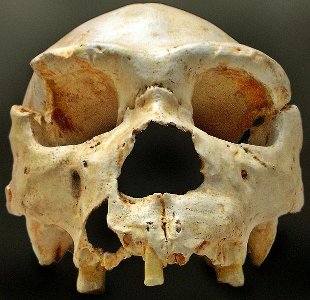
A team of scientists led by Dr. Svante Pääbo of the Max Planck Institute for Evolutionary Anthropology in Leipzig, Germany, has almost completely sequenced the mitochondrial DNA taken from a femur of a hominid who lived about 400,000 years ago. It’s the oldest hominid DNA sequenced so far and gave unexpected results, revealing a genetic connection with the Denisova, a population of hominids still poorly known.
This fossil femur, together with the bones of nearly 30 individuals including the skull in the picture (©José-Manuel Benito), was found at a site in northern Spain, near the city of Atapuerca, not surprisingly called Sima de los Huesos, which means pit of bones. According to a preliminary analysis, these individuals belonged to an archaic form of Neanderthals or their predecessors, the species Homo heidelbergensis. The analysis of mitochondrial DNA, however, has provided amazing results.
Dr. Svante Pääbo is one of the founders of paleogenetics, the discipline that studies the DNA of ancient humans. Thanks to him and his staff in recent years there have been significant advances in genetic research on hominids. In March 2013, he announced that he completed the sequencing of the DNA of a Neanderthal.
The recent sequencing at least partial of ancient hominids DNA allowed to compare the genetic characteristics of the various species. The Homo Denisova is a species that has probably coexisted with both Neanderthals and modern humans only a few of their bones have been found in Siberia. For this reason, we don’t know exactly their physical characteristics.
The fact that the hominids who lived in Spain had an appearance similar to the Neanderthals but had genetic characteristics closer to the Denisovas is baffling paleogeneticists and paleontologists. It’s possible that the Denisovas too were the descendants of the species Homo heidelbergensis just like the Neanderthals and this would explain why the Spanish hominids have characteristics of both.
The next step will be to try to sequence the DNA from the cell nucleus of this or any other individuals. It’s a very difficult task given the considerable age of those bones. Until a few years ago it would have been impossible but sequencing techniques have made great leaps forward so with a lot of patience to look for pieces of DNA still intact they could do it. It would be a great achievement to have the chance to compare at least part of the DNA of those ancient inhabitants of Spain with that of other species of hominids who lived at the time and with modern humans.
[ad name=”eBayUSUKFossils”]


Permalink